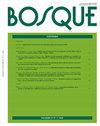量化智利森林流域在采伐作业期间细泥沙源对泥沙产量贡献的时间变化
IF 0.6
4区 农林科学
引用次数: 2
摘要
指纹技术被纳入智利南部的一项成对集水区调查,以量化三种精细沉积物来源(集水区表面、森林道路和溪流通道)在森林采伐和重新种植操作期间对集水区悬浮沉积物产量的贡献。用于沉积物来源判别和分配的最佳复合指纹包括整个研究期间控制流域(LUC)和收获前处理流域(LUT)的137Cs和210Pbex,以及收获和收获后LUT的137 Cs和土壤有机质。在收获之前,两个集水区的主要泥沙来源是河道,并且在整个土地利用变化研究过程中保持相对恒定。在整个研究期间,LUT的总悬浮泥沙产量(3160 kg ha-1)大约是LUC的两倍(1650 kg ha-1。这种差异的大部分原因是清除后雨季沉积物产量的增加。LUT中与森林作业相关的干扰导致集水区斜坡和森林道路对负荷的贡献显著增加(总贡献分别为835和795 kg ha-1)。然而,在研究期间,河道对LUT的总贡献(1530 kg ha-1)与LUC的贡献相似。调查结果表明,任何减少森林采伐沉积物负荷的尝试都需要采取最佳管理做法,以减少集水区表面和森林道路的沉积物流动。本文章由计算机程序翻译,如有差异,请以英文原文为准。
Quantifying the temporal variation of the contribution of fine sediment sources to sediment yields from Chilean forested catchments during harvesting operations
Fingerprinting techniques were incorporated into a paired catchment investigation in southern Chile to quantify the contribution of three fine sediment sources (catchment surfaces, forest roads and stream channels) to catchment suspended sediment yields during forest harvesting and replanting operations. Optimum composite fingerprints for use in sediment source discrimination and apportionment comprised 137Cs and 210Pbex for the control catchment (LUC) throughout the study and for the treatment catchment (LUT) during the pre-harvest period, and 137Cs and soil organic matter during harvest and post-harvest periods for LUT. Prior to harvesting, the dominant sediment source to the sediment load in both catchments was the stream channel and remained relatively constant throughout the study for LUC. For the entire study period the total suspended sediment yield from LUT (3,160 kg ha-1) approximately doubled that from LUC (1,650 kg ha-1). Most of this difference is accounted for by the increase in sediment output during the rainy months following clearcutting. The disturbance associated with forest operations in LUT caused the contributions to the load from the catchment slopes and forest roads to increase markedly (total contributions 835 and 795 kg ha-1, respectively). However, the total contribution from the stream channel for LUT during the study period (1,530 kg ha-1) remained similar to that from LUC. The results of the investigation demonstrated that any attempt to reduce sediment loading from forest harvesting would require adopting best management practices to reduce sediment mobilization from catchment surfaces and forest roads.
求助全文
通过发布文献求助,成功后即可免费获取论文全文。
去求助
来源期刊

BOSQUE
Agricultural and Biological Sciences-Forestry
CiteScore
0.70
自引率
0.00%
发文量
0
期刊介绍:
BOSQUE publishes original works in the field of management and production of forestry resources, wood science and technology, silviculture, forestry ecology, natural resources conservation, and rural development associated with forest ecosystems. Contributions may be articles, rewiews, notes or opinions, Either in Spanish or English.
 求助内容:
求助内容: 应助结果提醒方式:
应助结果提醒方式:


